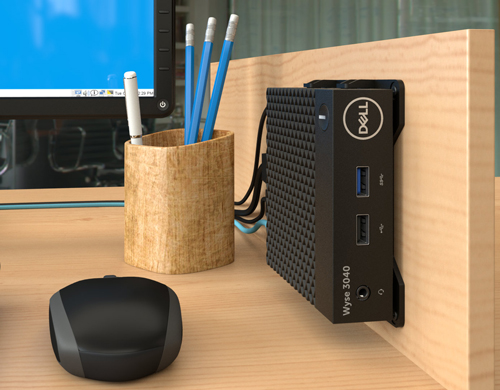News
Beefy Processor Dropped Into New Dell Thin Client
The quad-core processor is a first in its Wyse line of devices.
- By Scott Bekker
- 03/28/2017
Thin clients aren't famous for their fire-breathing processors. Although this makes them useful in many scenarios, in others it can become a serious limitation.
Dell wants its customers to have their thin-client cake and eat it, too.
The company refreshed its Wyse thin client line on Tuesday with a new device that sports the first quad-core processor in one of its entry-level devices for virtual workspace environments.
The Wyse 3040 has a lot of the specs you'd expect in a refreshed line -- lower weight at just over half a pound, about a quarter less power usage than previous models and a smaller overall size.
But Jeff McNaught, vice president of marketing and chief strategy officer for the Cloud Client Computing Unit at Dell, says the quad-core processor was a key enhancement to ensure lifetime value and flexibility for the little box.
"We selected a quad-core processor because one of the big tenets that we have with thin clients is delivering a device that can work for 8-10 years," McNaught said in an interview. "What we had found in the past with some other designs was that customers were [in] great [shape] as long as they didn't change their software strategy."
Specifically, the Intel Atom X5 1.44GHz quad-core processor with as much as 2GB DDR3 RAM and 8GB flash will help the 3040 support light multimedia activity and local application processing.
 Dell's new Wyse 3040 thin client. (Source: Dell.)
Dell's new Wyse 3040 thin client. (Source: Dell.)
The Dell team focused on a future Skype for Business use case, which is emerging as part of more and more business scenarios.
"With that quad-core processor, we licensed some key technology from Citrix and from Microsoft to be able to handle products like Skype for Business very effectively. Virtual environments have challenges -- called the trombone effect and the back-on-itself effect, where you have multiple video and audio streams operating simultaneously. This product is designed to be able to use the server to set up the call; but then once the call is set up, it operates with the target in a peer-to-peer manner, and that reduces the amount of bandwidth that's needed by a lot," McNaught said. "We needed to use a processor that had a tremendous amount of performance, and we needed to be able to have encode and decode handled separately from everything else you see on that screen delivered by Citrix, Microsoft or VMware."
With a starting price of $329, it's in the same price range as Wyse's current starter entries -- the single-core 3010 and the dual-core 3020 and 3030. The 3030 will remain on the market.
The Wyse 3040 will initially ship with the Wyse ThinOS software. Starting in June, Wyse will offer a new thin client option called Wyse ThinLinux. McNaught described ThinLinux as a thin-client-focused and hardened version of SUSE Linux that expands the use case for a thin client: "[You will] be able to have a local browser and to embed specific Linux applications right into that thin client. A lot of our customers like to do that because they might be replacing a PC with that thin client."
About the Author
Scott Bekker is editor in chief of Redmond Channel Partner magazine.